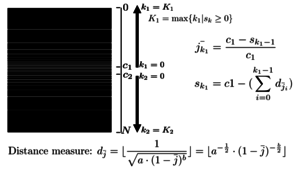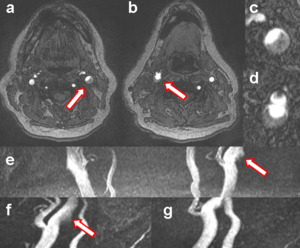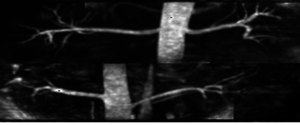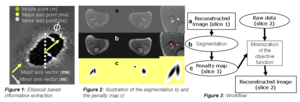
Dr.-Ing. Jana Hutter
Alumnus of the Pattern Recognition Lab of the Friedrich-Alexander-Universität Erlangen-Nürnberg
-


The combination of parallel MRI techniques with compressed sensing ideas is an active field of research. The expected benefit is a gain in aquisition time. The aim of this work is to compare different sampling schemes for highly undersampled non-contrast-enhanced MR angiography (MRA) and to derive an optimized scheme in the combination with iterative reconstruction. In this context, context, an inverse root pattern is proposed for optimized artifact removal and vessel delineation.
Experiments showed that the image quality obtained with the iterative reconstruction is highly dependent on the chosen pattern. With the inverse root pattern, it was possible to obtain high-quality results at very high undersampling factors.
Articles in Conference ProceedingsInverse root sampling pattern for iterative reconstruction in non-CE MR angiographyEuropean Society of Magnetic Resonance in Medecine and Biology (ESMRMB 2011), Leipzig, 06.10.-08.10.2011, vol. 24, pp. 92-93, 2011
-

In current clinical practice, examinations of the carotid artery
bifurcation are commonly carried out with Computed Tomography Angiography
(CTA) or contrast-enhanced Magnetic Resonance Angiography
(ce MRA). Quantitative information about vessel morphology, extracted
from segmentations, is promising for diagnosis of vessel pathologies.
However, both above-mentioned techniques require the administration
of contrast media.In contrary, non-ce MRA methods such as Timeof-
Flight (TOF) provide fully non-invasive imaging without any exogenous
contrast agent. The diagnostic value of TOF MRA, however, for
assessment of the carotid bifurcation area can be hampered due to its
susceptibility to irregular blood fow patterns. Conventional methods for
lumen segmentation are very sensitive to such signal voids and produce
inaccurate results.In this work, a novel, fully automatic 3D segmentation
algorithm is proposed which uses prior knowledge about irregular flow
patterns. The presented technique has been successfully tested on eleven
volunteer datasets as well as in a patient case, o ering the comparison
to CTA images. The sensitivity could be increased by 29.2% to 85.6%
compared to standard level set methods. The root mean squared error
in diameter measurements was reduced from 4.85mm to 1.44 mm.
The acquired datasets as well as manual segmentations are available under PASCAL.Articles in Conference ProceedingsPrior-based Automatic Segmentation of the Carotid Artery Lumen in TOF MRA (PASCAL)MICCAI 2012, Nizza, 01.10.-05.10.2012(to appear)
PASCAL.Articles in Conference ProceedingsPrior-based Automatic Segmentation of the Carotid Artery Lumen in TOF MRA (PASCAL)MICCAI 2012, Nizza, 01.10.-05.10.2012(to appear)
-

In non-contrast-enhanced 3D MR angiography (non-ce 3D MRA) of the renal arteries, long acquisition times are typically needed, which can impede clinical use. Recently proposed iterative methods offer the combination of parallel MRI with compressed sensing for the reconstruction of highly undersampled data. The application of a dedicated undersampling pattern in combination with an optimized iterative reconstruction algorithm for non-ce 3D MRA of the renal arteries is shown and the feasibility of different acceleration factors is studied. This is accomplished through evaluation of the sharpness, the contrast and the maximal visible blood length of the vessels.
Articles in Conference ProceedingsHighly accelerated non-contrast enhanced MRA of the renal arteries using iterative reconstructionInternational Society of Magnetic Resonance in Medecine (ISMRM 2012), Melbourne, 05.05.-11.05.2012
-

Compressed sensing algorithms minimize the target function, consisting of a data fit term (involving the parallel MRI reconstruction matrix) and of regularization terms.
This abstract presents a new regularization idea especially for angiographic data which uses the continuity of vessels as prior knowledge for the regularization.Articles in Conference ProceedingsVessel prior-knowledge regularization for MR angiographyEuropean Society of Magnetic Resonance in Medecine and Biology (ESMRMB 2011), Leipzig, 06.10.-08.10.2011, vol. 24, pp. 248, 2011Vessel Adapted Regularization for Iterative Reconstruction in MR AngiographyInternational Society of Magnetic Resonance in Medecine (ISMRM 2012), Melbourne, 05.05.-11.05.2012




